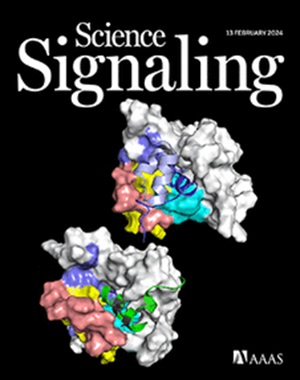ChREBP-mediated up-regulation of Them1 coordinates thermogenesis with glycolysis and lipogenesis in response to chronic stress
IF 6.6
1区 生物学
Q1 BIOCHEMISTRY & MOLECULAR BIOLOGY
引用次数: 0
Abstract
Activation of thermogenic brown adipose tissue (BAT) and inducible beige adipose tissue (BeAT) is triggered by environmental or metabolic stimuli, including cold ambient temperatures and nutrient stress. Thioesterase superfamily member 1 (Them1), a long-chain fatty acyl-CoA thioesterase that is enriched in BAT, suppresses acute cold-induced thermogenesis. Here, we demonstrate that Them1 expression was induced in BAT and BeAT by the carbohydrate response element binding protein (ChREBP) in response to chronic cold exposure or to the activation of the integrated stress response (ISR) by nutrient excess. Under either condition, Them1 suppressed energy expenditure. Consequently, mice lacking Them1 in BAT and BeAT exhibited resistance to obesity and glucose intolerance induced by feeding with a high-fat diet. During chronic cold exposure or ISR activation, Them1 accumulated in the nucleus, where it interacted with ChREBP and reduced the expression of its target genes, including those encoding enzymes that mediate glycolysis and de novo lipogenesis. These findings demonstrate that in response to chronic cold- or nutrient-induced stress, the induction of Them1 by ChREBP limits thermogenesis while coordinately reducing glucose utilization and lipid biosynthesis through its distinct cytoplasmic and nuclear activities. Targeted inhibition of Them1 could be a potential therapeutic approach to increase the activity of BAT and BeAT to enhance energy expenditure in the management of obesity-associated metabolic disorders.
在慢性应激反应中,chrebp介导的Them1上调与糖酵解和脂肪生成协调产热。
热源性棕色脂肪组织(BAT)和诱导性米色脂肪组织(BeAT)的激活是由环境或代谢刺激触发的,包括寒冷的环境温度和营养胁迫。硫酯酶超家族成员1 (Them1)是一种长链脂肪酰基辅酶a硫酯酶,在BAT中富集,可抑制急性冷致产热。本研究表明,在BAT和BeAT中,碳水化合物反应元件结合蛋白(ChREBP)在慢性冷暴露或营养过剩激活综合应激反应(ISR)时诱导了Them1的表达。在这两种情况下,Them1都抑制了能量消耗。因此,在BAT和BeAT中缺乏Them1的小鼠表现出对高脂肪饮食引起的肥胖和葡萄糖耐受不良的抵抗。在慢性冷暴露或ISR激活过程中,Them1在细胞核中积累,在那里它与ChREBP相互作用,降低其靶基因的表达,包括介导糖酵解和新生脂肪生成的编码酶。这些发现表明,在应对慢性寒冷或营养诱导的应激时,ChREBP诱导的Them1限制了产热,同时通过其独特的细胞质和核活动协调降低了葡萄糖利用和脂质生物合成。靶向抑制Them1可能是一种潜在的治疗方法,可以增加BAT和BeAT的活性,从而在肥胖相关代谢紊乱的管理中增加能量消耗。
本文章由计算机程序翻译,如有差异,请以英文原文为准。
求助全文
约1分钟内获得全文
求助全文
来源期刊

Science Signaling
BIOCHEMISTRY & MOLECULAR BIOLOGY-CELL BIOLOGY
CiteScore
9.50
自引率
0.00%
发文量
148
审稿时长
3-8 weeks
期刊介绍:
"Science Signaling" is a reputable, peer-reviewed journal dedicated to the exploration of cell communication mechanisms, offering a comprehensive view of the intricate processes that govern cellular regulation. This journal, published weekly online by the American Association for the Advancement of Science (AAAS), is a go-to resource for the latest research in cell signaling and its various facets.
The journal's scope encompasses a broad range of topics, including the study of signaling networks, synthetic biology, systems biology, and the application of these findings in drug discovery. It also delves into the computational and modeling aspects of regulatory pathways, providing insights into how cells communicate and respond to their environment.
In addition to publishing full-length articles that report on groundbreaking research, "Science Signaling" also features reviews that synthesize current knowledge in the field, focus articles that highlight specific areas of interest, and editor-written highlights that draw attention to particularly significant studies. This mix of content ensures that the journal serves as a valuable resource for both researchers and professionals looking to stay abreast of the latest advancements in cell communication science.
 求助内容:
求助内容: 应助结果提醒方式:
应助结果提醒方式:


